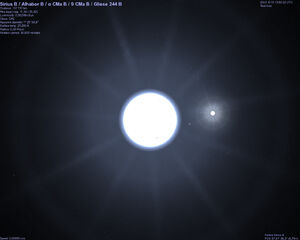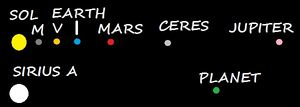For a classification of stars see The H-R Diagram. Additional information can be found at Main Sequence A Type Stars - Habitable Simulation and Main Sequence Stars.
A - type stars are more rare than K - type stars, G - type stars or F - type stars (which are similar to our sun, Sol). Because of their luminosity, they are the second most common stars in the night sky, after B - type stars. Some of the brightest stars we see are A - type stars, including Sirius A, Vega, Altair or Fomalhaut. As long as speed of light remains a hard barrier for cosmic transportation, many settlers will look at these stars as possible destinations. They have a large Habitable Zone.
The star[]
A - class stars have weak solar winds owing to a lack of an internal dynamo . Their lifetime is far shorter. Once they have used all hydrogen, they begin to fuse helium, slowly leaving main sequence and transforming into red giants. In the end, they become white dwarfs. This is not a problem for settlers, because human lifetime is extremely small compared to a star.
These stars do have planets. In fact, one of the first extrasolar planets was discovered around Fomalhaut. Some people suggest that since these stars have a shorter lifetime, planets would not have enough time to develop into Earth-like bodies (if continents exist, they would be small and highly volcanic). However, a well-established planet could have been captured from another star.
A - class stars are more massive than Sol and they spin faster, creating a more powerful magnetic field. Despite this, solar flares are not a threat to nearby planets, compared to the average solar wind. There is also an advantage: the strong magnetic field, completed with a powerful solar wind, keeps interstellar environment further away from the planet.
Based on the blackbody radiation theory, the peak of Sirius's radiation is somewhere between blue and ultraviolet, while for Sol, it is in yellow. As a direct result, A - class stars generate a lot of UV radiation. In visible light, they produce more blue than red light and far less infrared light.
Hosted planet[]
The best orbit inside Habitable Zone further away than what we see in our solar System. One interesting model places a planet around Sirius at 4 AU, closer to the orbit of Jupiter in Solar System. Another model proposes a habitable planet at 4.7 AU, with an orbit of 6.8 Earth years.
A planet orbiting Sirius at nearly 5 AU (the orbit of Jupiter) will experience very long years. If that planet is tilted like Earth, seasons will last over a year. This will be a major challenge for plants and animals to adapt. Also, the amount of snow that will accumulate in winter will require long time to melt, creating floods. If we assume an Earth-like climate model, with same weather regions, we see some hard places. In the savanna, long rain seasons will help huge populations of animals to develop, while the 4-years dry season will strike famine and will even destroy many plants. Will temperate plants survive a winter that lasts for 4 years? Most probably, no. However, small annual plants will survive. Their seeds will make it through the winter. Animals will have no chance to hibernate that long. Migrations will be the only way to survive.
How would humans adapt to such long seasons? People can harvest crops multiple times during temperate summers and wet seasons, so they can survive in long winters. But another better option would be to migrate. Modern nomads will have a chance in this environment. If food is not enough for the long winter, famine will start, followed by war.
At its distance to the parent star, tidal forces are small, so that rotation period will not be slowed down. Planet's gravitation sphere is larger, meaning that moons have a higher chance to exist. Both these conditions support for the existence of a planetary dynamo, powering a magnetic field, required to face a strong solar wind. Around a gas giant orbiting at its best distance, many moons can be suitable for life. If the system is made of rocky planets, since habitable zones extend up to 3 AU, there might be many planets that don't need to change their average temperature in order to terraform.
The largest problem for life is the strong ultraviolet radiation. An ozone layer might not be enough for protection. For settlers on a terraformed planet, it is not a good idea to keep your skin uncovered. Clothes should be used always, even at the beach. Another possibility is that people will start to paint their skin, just like today we paint our hair and nails. It will also be hard for plants and animals to adapt in this environment, but not impossible.
Extended habitable zone
It will be hard to terraform inner, warmer planets. Technologies proposed for Mercury and Venus might not be useful. A strong solar wind will blow away orbiting mirrors. One sci-fi novel proposed the use of a special gas, that reflects heat in day time and becomes highly permeable for infrared light during night time. Another solution should be something to reflect part of visible and ultraviolet light, while allowing infrared light (radiated by the planet) to pass. Atmospheric balloon-mirrors can also be used.
For the outer planets, the best way to terraform is by using greenhouse gasses. In Solar System, these gases can be used to terraform even Kuiper Belt Objects, even if plants will not survive beyond the orbit of Neptune without an additional source of light. Plants need both red and blue light, both at an intensity of at least 0.1% to what they receive on Earth. The main problem is that A - type stars lack of red light. These stars generate 100% of Sol's blue and 50% of its red. So, Earth-like plants will survive to the point where red light drops to 0.1% of what is found on Earth, while genetically modified plants, able to use blue and ultraviolet light, will be able to survive up to where total light output is 0.1% of the luminosity on Earth. Based on this, we can draw the following limits for Sirius A:
- Best orbit for terraforming: 4.7 AU
- Outer distance for Earth-like plants reflecting off green light: 105 AU
- Outer distance for Earth-like plants using green light for photosynthesis: 123 AU
- Outer distance for genetic-modified plants: 148 AU
Compared to other stars, A - type stars offer a large Habitable Zone. If we place Sirius in Solar System, life can brought even on Sedna!
The outer limit of extended habitable zone is so far that it might extend out of Sirius's magnetosphere. The strong solar wind blows further away, keeping interstellar environment away from terraformed planets.
Despite the challenges, A - class stars have huge habitable zones, covering a multitude of possible planets.

